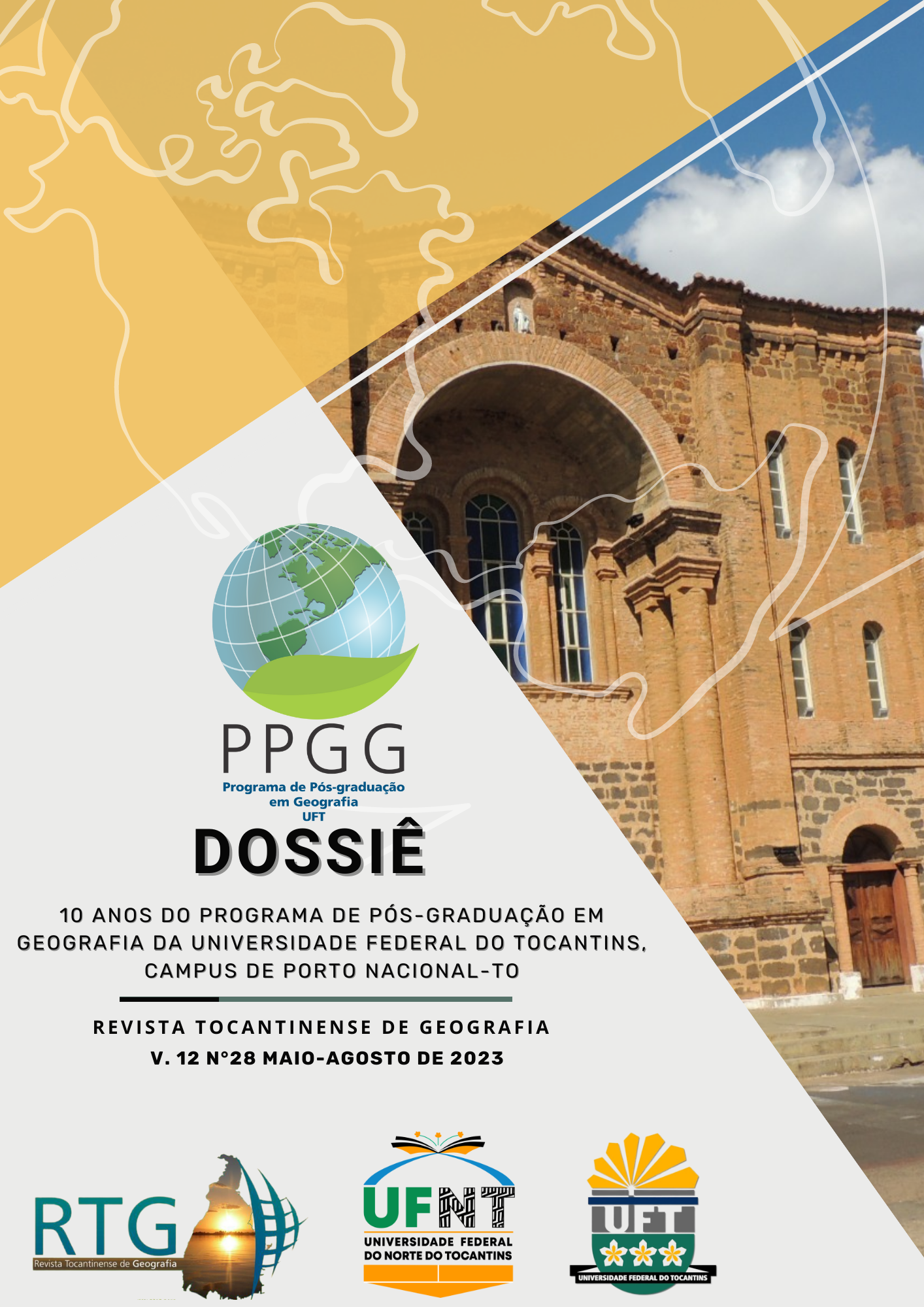A TERRITORY MARKED BY VIOLENCE
THE 1940 MASSACRE AND THE TERRITORIAL RESISTANCE OF THE KRAHÔ INDIANS IN THE NORTHEAST OF THE STATE OF TOCANTINS
DOI:
https://doi.org/10.20873/rtg.v12i28.16655Keywords:
Krahô territory, Krahô villages, indigenous peopleAbstract
This work is a study based on the historical materiality of the facts, about the destruction of the territories of the Krahô indigenous nation. It is also part of a set of essays resulting from debates between students of the Master's in Geography at the Federal University of Tocantins (Porto Nacional Campus). In the quest to analyze the processes of violence against the Krahô Indians in the defense of their territory, it was found that the 1940 massacre represents the centrality of the issue. The social relations established between indigenous people and peasants were inferred from access to archives and bibliography on the subject, in addition to field work. The conflicting relations maintained between the Krahô and the Pastoral expansion front, with the consent of the State and the Church, resulted in the destruction of the traditional territory (cosmologically infinite) in the south of Maranhão, and in the demarcation of a new confined, finite and discontinuous territory. in the municipality of Itacajá, Northeast of the state of Tocantins.
References
ABREU, J. Capistrano de. Caminhos Antigos e Povoamento do Brasil. RJ. Liv. Briguiet. 1930.
ALENCASTRE, José Martins Pereira de. Anais da Província de Goiás – 1863. Brasília: Gráfica Ipiranga, S/D.
ANDRADE, Manoel Correia de. A questão do Território no Brasil. PE.: Hucitec, 1995.
ARNAUD, Expedito. Aspectos da Legislação sobre os Índios do Brasil. Public.
Avulsas nº 22, Mus. E. Goeldi, 1975.
AUDRIN, José M. Entre sertanejos e índios do Norte. R. J.: Ed. Agir, 1947
BURCHEL, William John. O Brasil do Primeiro reinado visto pelo Botânico (1825/1829). RJ. FN. Pró-memória, 1981.
CABRAL, Maria do Socorro C. Caminhos do Gado: Conquista e Ocupação do Maranhão. MA, SECMA, 1992.
CHAIM, Marivone Matos. Os aldeamentos indígenas na capitania de Goiás: Sua importância na política de Povoamento (1749-1811)”,Goiânia: Gráf. do Livro Goi., 1974.
CHIARA, Vilma. “Folclore Krahô” Revista do Museu Paulista. N.S., Vol. 13 São Paulo, pp. 333-375, 1961/1962
COLARES, Francisco. Bia – Amor e Dor. RJ: Ed. Juerp, 1976.
CUNHA, Manoela Carneiro da. Antropologia do Brasil: Mito, história, Etnicidade. SP. Brasiliense, 1986
IBGE, Carta Topográfica de Itacajá, Esc. 1:1000.000 Sec. Pla. Pres. da República, 1980.
MARTINS, José de Souza. Expropriação e Violência: a questão política no Campo. 3ª Ed. SP. Hucitec, 1991
MARX, Karl. A origem do capital: a acumulação primitiva. São Paulo: Ed. Global, 1977
MEIRELES, Cildo. Memorial que faz Cildo Meireles. Escriturário do SPI (Ministério da Agricultura) Ao Sr. Modesto Danatini, diretor do mesmo serviço, sobre a Craolândia, propriedade particular dos índios Craô, Município de Pedro Afonso, Goiás, Mímeo, Arq. Hist. Clara Galvão, FUNAI/BSB, 1949.
MELATTI, Júlio César. Ritos de uma tribo Timbira, Ensaios, 53, S P: Editora Ática, 1978
MELATTI, Júlio César. Índios e criadores: a situação dos Krahô na Área pastoril do Tocantins. Monografia do Instituto de Ciências Sociais, Rio de Janeiro, UFRJ, 1967, v. 3.
MELATTI, Júlio César. Questões sobre a identidade Krahô. RJ Anuário Antropológico. Ed. UFC, 1984, pp. 184,194
MELATTI, Júlio César. Reflexões sobre algumas narrativas Krahô. Brasília: FUB, 1974 (série Antropologia, 8, Dpto. De Ciências Sociais).
NIMUENDAJÚ, Curt. The Eastern Timbira. University of. California Publications in Américan Archeology and Edhnology, Vol. 41, Berkeley and Los Angeles, 1946.
NIMUENDAJÚ, Curt. The Apinayé. The Catholic University of America Antropological series, n. 8, The Catholic University of America Press, Washington, D. C., 1939.
O RADICAL (Jornal). Vão ser soltos os assassinos dos índios Craôs no Estado de Goiás, 9/11/1941. BSB. Arq. Hist. Clara Galvão. Microfilme nº 00572
OLIVEIRA A.U. A Fronteira Amazônica Mato-Grossense: Grilagem Corrupção e Violência. SP. USP, FFLCH, Livre Docência, Mímeo 1997
OLIVEIRA JUNIOR, Eurípedes M. de. Culturas em Confronto: Trajetória e redefinição do Espaço Krahô. Goiânia FCHF – UFG. Dissert. Mímeo, 2000.
RAFFESTIN, Caude. Por uma Geografia do poder. SP, Ática, 1993.
RAMOS, Alcida Rita. Sociedade indígena. São Paulo; Ática, 1986
RIBEIRO, Darcy. A política indegenista brasileira. RJ, Ministério da Agricultura, 1962
RIBEIRO, Darcy. Os Índios e a Civilização. SP. CIA das Letras, 1996.
RIBEIRO, F. de Paula. Descrição do Território de pastos Bons, nos sertões do Maranhão:. Rev. do Inst. Hist. Geog. Brasileiro. nº 12. Rio de Janeiro, 1874, p. 41-86.
RIBEIRO, F. de Paula. “Memória sobre as nações Gentias que presentemente habitam o continente do Maranhão Rev. do Inst, Hist. Geog. Brasileiro., nº 3. Rio de Janeiro, 1841, p. 184-197, 297-322 e 442-456.
RIBEIRO, F. de Paula. Roteiro da viagem que fez o capitão Francisco de Paula Ribeiro as Fronteiras da Capitania do Maranhão e da de Goyaz no ano de 1815 em serviço de S.M. fidelíssima. Rev. do Inst. Hist. e Geog. Brasileiro, 1º trim. Rio de Janeiro, 1848.
ROCHA, L. Mendes, O Estado e os Índios: Goiás 1850-1889. Goiânia: Ed. UFG, 1998.
SANTOS, Milton. Território e Sociedade. 2ª ed. SP. FPA 2000.
TAGGIA, Rafael (Frei). Mapa Dos Índios Charaôs da Aldeia de Pedro Afonso ao Norte da Província de Goyaz. Rev. IHGB, 1889.
Downloads
Published
How to Cite
Issue
Section
License
Copyright (c) 2023 Tocantinense Journal of Geography

This work is licensed under a Creative Commons Attribution-NonCommercial-NoDerivatives 4.0 International License.
Revista Tocantinense de Geografia does not remunerate any author for the publication of their texts. The contents of the texts published in this journal are the responsibility of the authors.









.png)












